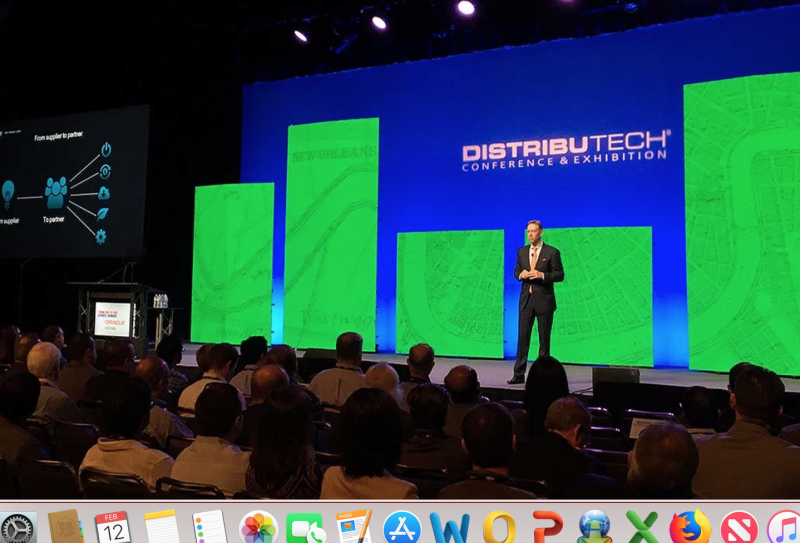Consumer behavior dictates what future utility industry looks like now, Entergy exec says

Long-term success in the utility industry is dependent upon its ability to provide products and services that meet and exceed the expectations of both shareholders and customers, said Paul Hinnenkamp, executive vice president and chief operating officer at Entergy Corp., during a Feb. 5 keynote address at the DistribuTECH 2019 Conference & Exhibition held in New Orleans.
“How many of you woke up this morning and said, ‘I have to buy me some electricity?’ You didn’t, and you probably never have,” said Hinnenkamp, who helps run an integrated energy giant that’s primarily engaged in electricity production and retail distribution operations that generate roughly $11 billion in annual revenues, serves 2.9 million utility customers in Arkansas, Louisiana, Mississippi and Texas, and employs more than 13,000 people.
“The truth is, customers don’t want the electricity we provide. They want the outcomes electricity provides,” he said.
Such a modern mindset already is impacting consumer behavior patterns, said the executive, who advised that the utility industry shift its focus to accommodate it.
“We have to move from providing customers with an input to providing the products and services customers want to power their lives,” said Hinnenkamp, who has been with Entergy since 2001. “We must focus on and deliver the new outcomes customers want.”
That means moving from a supplier to a partner, he said, and shifting from a ratepayer mentality to a customer-driven mentality. “We must solve problems with and for our customers,” said the COO, who assumed that title in November 2015.
Hinnenkamp currently is responsible for executive oversight of safety and human performance, fossil generation, transmission, system planning, capital projects management and compliance with North American Electric Reliability Corporation Critical Infrastructure Protection standards.
He previously served as senior vice president of Entergy’s capital projects management and technology, an organization created in 2013 to ensure the company’s $8 billion investment in capital projects was effectively managed and executed. Hinnenkamp and the capital project management team led the development of Ninemile 6, the first power plant built by an Entergy utility in Louisiana in 30 years, according to the company, which said the December 2014 completion date was two months ahead of schedule and about $90 million under budget.
“The grid is more than 100 years old. It’s still a marvel today, but it’s past time to ask ourselves: What will utilities look like in 20 years?” he said during his keynote address.
Grid modernization efforts, such as advanced meters, distribution automation, electric vehicles, smart thermostats, and wireless charging systems, among others, will continue across the industry, Hinnenkamp surmised, particularly as utilities gain better information about how customers use the utilities’ products.
“What new products and services will be informed by today’s investments in data analytics?” he asked conference attendees.
At Entergy, Hinnenkamp said technologies are being deployed now that offer a wide range of benefits.
“We’ll use that technology to help deliver world-class service,” he said, adding that the company is investing in generation, transmission and distribution.
In the area of generation, for instance, he said Entergy is expanding green energy options.
“We’ve got almost 5 Gigawatts (GW) of new generation in various phases of development and construction, comprised of gas, acquisitions and renewables,” Hinnenkamp said. “We’re also pursuing 1000 Megawatts (MW) of renewable generation. That number is expected to grow as the economics, performance and reliability of these resources continues to improve.”
Regarding transmission, Entergy in 2018 put more than $1 billion of new transmission facilities into service, including 67 major projects, 205 miles of new lines and 10 new substations, according to the executive, who said 96 miles of existing lines and 100 substations also were upgraded.
Distribution efforts at Entergy include grid modernization projects, such as the installation of three million automated meters that will provide customers with transparent energy management tools and enable the company to offer new energy-saving programs.
“This effort will enhance reliability and allow for more accurate detection of problems and faster response times,” Hinnenkamp said. “And we’re doing all of this while providing power at some of the lowest rates in the country.”
What a future utility looks like may well seem uncertain, he said, “but we know that to get there, we have to execute on what is in front of us extremely well, radically improve the customer experience, and create a high-performing, flexible organization.”
Entergy’s current vision mantra, Hinnenkamp said, is ‘We Power Life,’ including homes, hospitals, schools and industry. “And we’re preparing for a future in which we remain at the core of our customers’ lives, continuing to power the communities we serve,” he said.
Along those lines, Entergy’s plans are to deliver top-quartile customer satisfaction; achieve top-decile corporate social responsibility performance; and provide top-quartile results to owners, according to the presentation slides Hinnenkamp showed during his speech.
The future also includes workforce development, efficient vertical integration, holding down rates, and providing clean generation, among other characteristics, according to his slides.
Regarding corporate social responsibility, Entergy plans to maintain its success, Hinnenkamp said.
“Exceeding environmental requirements is nothing new for Entergy,” said Hinnenkamp, who noted that the company in 2001 became the first utility in the United States to voluntarily commit to stabilizing carbon dioxide (CO2) emissions.
“We’ve extended that commitment twice,” the executive said. “Most recently, we made a voluntary pledge to maintain our CO2 emissions at 20 percent below year 2000 levels through 2020.”
